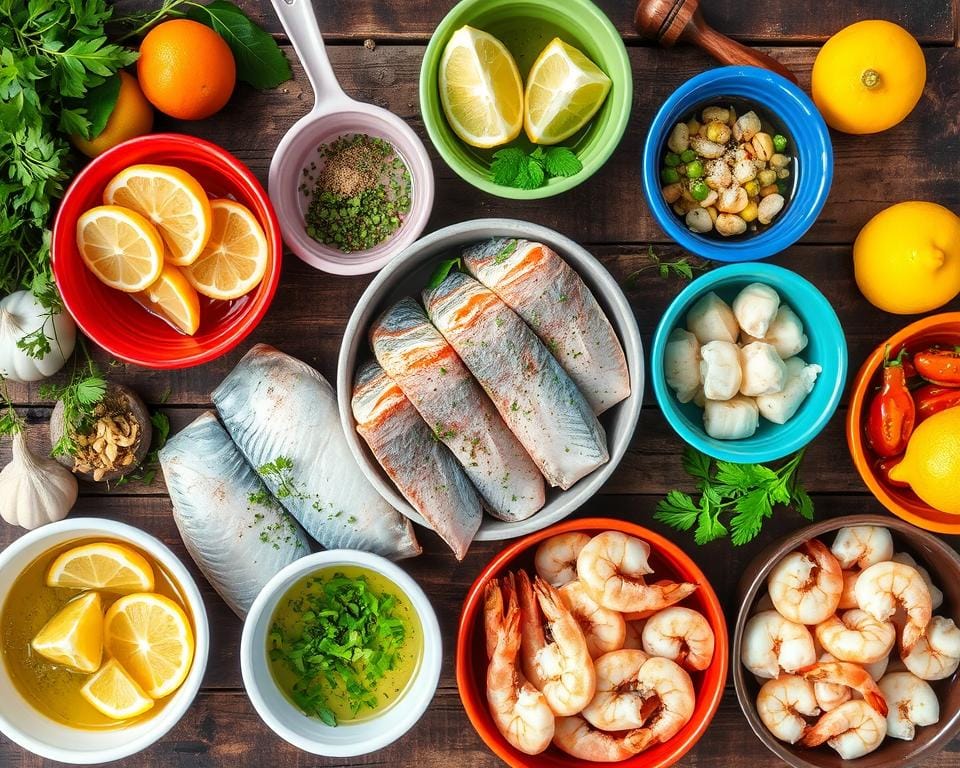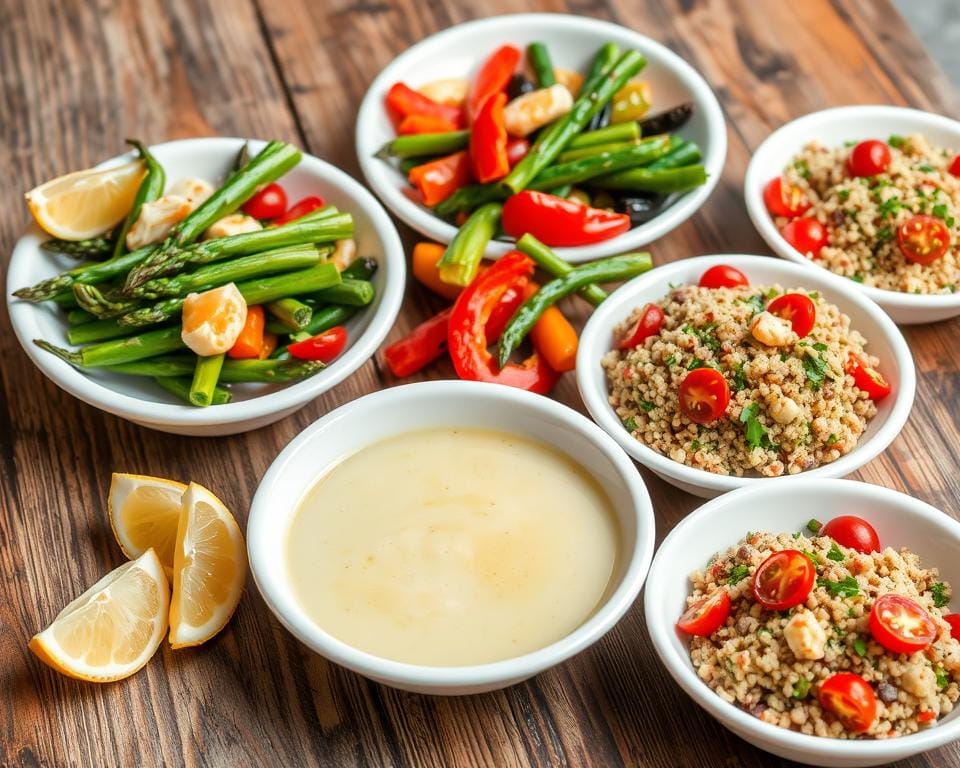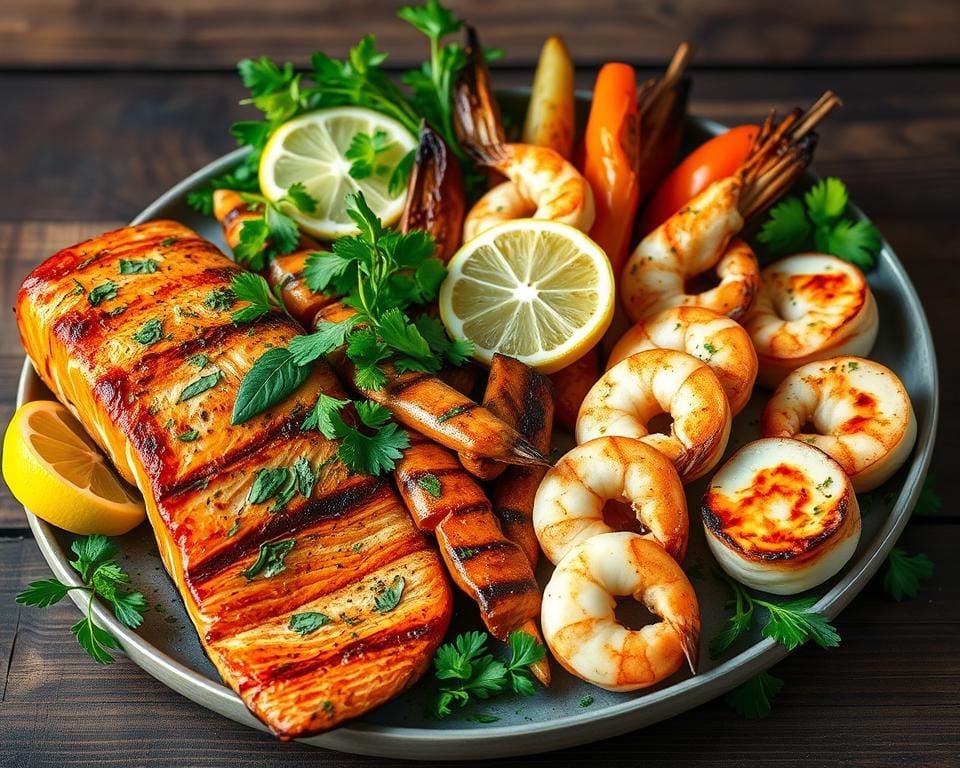How to create healthy seafood dishes at home
I remember the first time I cooked a fresh fish fillet at home. The smell of sizzling butter and the sound of it searing were amazing. The fish was tender and flaky, a real discovery for me.
Since then, I’ve aimed to cook delicious, healthy seafood dishes at home. If you love seafood as much as I do, you’re in the right place. This guide will teach you how to pick the best ingredients and cook them perfectly.
You’ll learn to make tasty seafood recipes that everyone will love. Whether you’re experienced in cooking or just starting, you’ll find tips to make your seafood dishes both healthy and flavorful.
Table of Contents
Essential Kitchen Tools and Equipment for Seafood Preparation
Preparing delicious seafood at home needs the right tools and equipment. Sharp knives and specialized shellfish tools are key. They help you handle, clean, and cook seafood with ease.
Basic Equipment for Fish Cleaning and Preparation
Begin with sharp fillet knives and fish tweezers for cleaning and filleting. A fish scaler is useful for removing scales. For shellfish, a quality oyster shucker and crab mallets make opening shells easy.
Specialized Tools for Shellfish Handling
Shellfish need special tools for handling. Use seafood bibs to keep your clothes clean. A crab cracker set helps break into crab and lobster shells. A clam bake bag is great for steaming clams or mussels.
Must-Have Cooking Vessels and Utensils
The right pots, pans, and tools are crucial for cooking seafood. A large stockpot is great for boiling seafood. A heavy-duty skillet is perfect for pan-searing. For baking, a ceramic grill lid keeps moisture and flavor in. Essential tools include a lemon press, seafood forks, and a butter warmer to enhance your dishes.
With these essential tools and equipment, you can make restaurant-quality seafood dishes at home.
“The delicacy of seafood requires careful handling to preserve its natural flavors,” emphasizes prominent seafood chef Rick Moonen.
Selecting Fresh Seafood: A Guide to Quality and Sustainability
Choosing the right seafood is key to making tasty dishes at home. When you’re at the seafood aisle or fishmonger, remember these tips. They help you pick the best fresh seafood and support sustainable seafood practices.
To check the seafood quality, look for clear eyes in fish and vibrant red gills. The flesh should be firm and elastic. For shellfish like clams, oysters, and mussels, the shells should be tight or snap shut when tapped. Stay away from seafood with a bad smell, as it might be spoiled.
- Fresh fish should have a mild, clean smell, not fishy or sour.
- Live clams, oysters, and mussels should close their shells when tapped.
- Seafood should be cooked to 145°F to be safe to eat.
To support sustainable seafood, look for MSC or ASC labels. These show the seafood was caught or farmed responsibly. Buying seafood in season and locally also helps the environment.
“Eating a variety of fish and shellfish can help your heart and support growth in kids.”
Knowing how to spot fresh seafood and choosing sustainable options makes your dishes tasty and eco-friendly. With a bit of knowledge, you can help our oceans and the people who live by them.
Fundamental Seafood Cooking Techniques
Learning to cook seafood at home is all about mastering different techniques. You’ll discover how to steam, poach, grill, and pan-sear. Each method brings out the best in your fish and shellfish.
Steaming and Poaching Methods
Steaming and poaching are gentle ways to cook seafood. Steaming uses simmering water or broth to add clean flavors. Poaching gently cooks seafood in seasoned liquid, making it tender and juicy.
These methods are great for keeping seafood’s natural sweetness and texture. They’re perfect for preserving the freshness of your catch.
Grilling and Pan-Searing Tips
Grilling adds a smoky flavor to fish, especially in summer. It’s best for thick fish like tuna or swordfish. They get a nice crust.
Pan-searing is quick and creates a crispy outside while keeping the inside moist. The secret is to control the heat and time to avoid overcooking.
Baking and Broiling Basics
Baking and broiling are versatile for many seafood dishes. Baking cooks at a moderate temperature, blending flavors. Broiling gives a caramelized crust.
These oven methods work for delicate fillets to hearty whole fish. Timing and temperature are key for flaky, moist seafood.
| Cooking Technique | Ideal Seafood | Cooking Time | Temperature |
|---|---|---|---|
| Grilling | Tuna, Swordfish, Salmon | 3-4 minutes per side | High heat (450°F+) |
| Pan-Searing | Halibut, Cod, Scallops | 3-4 minutes per side | Medium-high heat |
| Baking | Salmon, Trout, Shrimp | 10-15 minutes | 350°F |
| Broiling | Swordfish, Tuna, Lobster Tails | 5-8 minutes | High heat (500°F+) |
Learning the basics of seafood cooking techniques is crucial. It lets you explore the flavors and textures of your favorite seafood. From steaming to grilling, each method adds something special to your dishes.
Simple and Nutritious Seafood Dishes for Beginners
Exploring seafood doesn’t have to be hard. Whether you’re new to cooking or want healthy meals, there are many easy seafood dishes. Quick shrimp scampi and flavorful grilled salmon are great for beginners. They taste great and are good for you.
Begin with a grilled salmon fillet. It’s seasoned with lemon, herbs, and olive oil. This dish is full of flavor and easy to make. For something more filling, try a Mediterranean-style sole recipe. It’s baked with fresh veggies and Mediterranean flavors.
For a unique dish, try air-fried fish and chips. It’s a healthier version of a classic. The peanut butter shrimp recipe also offers a sweet and savory taste.
Choose any seafood dish and add lots of veggies and whole grains. This makes your meal balanced and nutritious. With these easy recipes, you’ll soon be a pro at cooking seafood.
“Cooking seafood at home has never been easier, and the results are truly delicious. These simple recipes are the perfect way to get started on your seafood journey.”
Start your seafood adventure with these easy recipes. You’ll soon feel like a pro at making healthy, tasty dishes.
Mastering Classic Seafood Recipes
Take your cooking to new heights with classic seafood recipes. These dishes take you on a journey from the Mediterranean to Asia and America’s coasts. They mix flavors and textures in a perfect way.
Mediterranean-Style Fish Preparations
Try Greek-style baked fish for a taste of rustic charm. It’s made with tender fish, juicy tomatoes, briny olives, and herbs. Or, imagine the Amalfi Coast with a seafood stew. It’s full of clams, mussels, and shrimp in a white wine and tomato broth.
Asian-Inspired Seafood Dishes
Dive into Asian seafood cuisine for bold flavors. Enjoy a soy-ginger glaze on grilled salmon or a Thai shrimp curry. It’s filled with lemongrass, galangal, and coconut milk.
American Coastal Favorites
Discover American coastal classics like New England clam chowder. It’s creamy and indulgent. Or try Cajun-style blackened fish for a bold taste. The seafood shines with Cajun seasonings.
Learn the secrets of these seafood recipes. Let your cooking journey explore the world’s coastal cuisines.
“When it comes to seafood, the quality of the ingredients is paramount. Sourcing the freshest, most sustainable options is the key to creating truly memorable dishes.” – Rick Moonen, Chef and Sustainability Advocate
Healthy Marinades and Seasonings for Seafood
Boosting the taste of your seafood is easy with the right marinade or seasoning. Say goodbye to high-calorie store-bought mixes. Instead, make your own marinades that taste great and are good for you. Try using citrus juices, fresh herbs, and spices to make even the simplest fish dishes burst with flavor.
Begin by mixing seafood marinades like Greek yogurt, olive oil, and lemon or lime juice. The yogurt adds creaminess without too much fat. The citrus softens the fish. Add herbs like dill, parsley, or cilantro for a fresh taste. For more flavor, use healthy seasonings like Cajun, Mediterranean, or Jamaican jerk.
| Marinade Ingredient | Benefits |
|---|---|
| Greek Yogurt | Provides a creamy texture and protein boost |
| Olive Oil | Healthy fats that enhance moisture and flavor |
| Citrus Juice | Tenderizes the seafood and adds a bright, tangy note |
| Fresh Herbs | Infuse the seafood with vibrant, herbaceous flavors |
When marinating seafood, keep it simple. Marinate fish, shrimp, or scallops for 30 minutes to an hour. This prevents them from becoming too soft. Always marinate in the fridge to avoid bacterial growth.
“Marinating seafood in a flavorful, low-calorie marinade is an easy way to elevate your meals without compromising nutrition.”
With a bit of creativity and a good pantry, you can make your seafood dishes stand out. Try different seafood marinades, healthy seasonings, and fish spices to find your favorite flavors.

Quick and Easy Seafood Dinner Solutions
Preparing tasty seafood meals at home is easy and fast. With simple techniques and quick recipes, you can enjoy healthy seafood dishes any weeknight. Check out our collection of 30-minute seafood meals, one-pan recipes, and make-ahead dishes for busy evenings.
30-Minute Seafood Meals
These 30-minute recipes save you time. Try pan-seared salmon with a tangy lemon-caper sauce or a shrimp and vegetable stir-fry. Both are ready in under half an hour. For a twist, make crispy tilapia with a refreshing citrus slaw quickly.
One-Pan Seafood Recipes
These easy one-pan meals make cooking simple. Bake a sheet pan with salmon, shrimp, and roasted veggies for a complete dinner. Or, make a seafood pasta bake with a creamy sauce and crispy topping in one dish.
Make-Ahead Seafood Dishes
Prepare seafood dishes ahead for more convenience. Make a seafood casserole or marinated grilled fish on the weekend. Then, reheat and serve on a busy weeknight. These options let you enjoy quick seafood dinners without the rush.
With these easy fish recipes and one-pan seafood meals, you have many quick seafood dinner options. You can easily get a delicious and healthy seafood meal ready in no time.
Pairing Side Dishes with Seafood
Creating a great seafood dish is just the start. The right side dishes can make it even better. You can choose from light salads to hearty roasted veggies.
Think about how your seafood is cooked. Grilled or pan-seared fish goes well with fresh salads. Try a mango and bell pepper salad or a cucumber and tomato salad to add a nice touch.
For baked or roasted seafood, pick side dishes that match its flavors. Roasted asparagus with trout almondine or roasted greens and shallots are great choices. Hearty grains like farro or quinoa also pair well, adding texture and nutrition.
- Sauvignon Blanc or Pinot Grigio are good wines for seafood boils. They have crisp acidity that cuts through the richness.
- Light lagers or wheat beers are perfect for seafood boils. They don’t overpower the flavors.
- For non-alcoholic drinks, sweet tea or lemonade are refreshing. Lemonade’s acidity balances the seafood’s richness.
- Mojitos or margaritas are good cocktail choices for seafood boils. Mojitos refresh with mint and lime, and margaritas balance the brininess with a salt rim.
Experimenting with different seafood side dishes, fish accompaniments, and vegetable pairings is key. By mixing textures, flavors, and cooking methods, you can create a memorable seafood meal.

Tips for Making Restaurant-Quality Seafood at Home
It’s easier than you think to make your seafood dishes as good as those in fancy restaurants. Just a few chef tricks and avoiding common mistakes can do the trick. You’ll be making seafood meals that look and taste amazing.
Professional Chef Techniques
First, season your seafood well. Use lots of salt, pepper, and spices to bring out the flavors. To get a great sear, heat your pan or grill high and dry the seafood before cooking. Try making your own butter or creamy sauces for extra flavor.
When cooking, timing and temperature are key. Fish takes 3-5 minutes per side, while shrimp and scallops need 2-4 minutes. Cook fish to 145°F (63°C) and shrimp/scallops to 120°F (49°C). Brining seafood in saltwater for 15-30 minutes keeps it moist.
Common Mistakes to Avoid
Don’t overcook your seafood. It should be tender, not tough. Check if the fish is opaque and flakes easily, or if shrimp/scallops are firm. Letting the seafood rest after cooking helps even out the heat and keeps it moist.
Also, avoid using low-quality or thawed badly. Delicate seafood needs gentle handling and careful thawing. And, don’t forget to plate your dishes nicely. It makes a big difference in how they look.
“The secret to cooking restaurant-quality seafood at home is all in the details – from seasoning and searing to timing and temperature control.”
Storing and Preserving Fresh Seafood
Keeping seafood fresh is key for tasty and healthy meals. Knowing how to store fish, shellfish, and other seafood is important. It makes a big difference in the quality of your dishes.
For seafood storage, keeping it cold is essential. Store fresh fish in the coldest part of your fridge. Use it within 1-2 days. For longer storage, freezing seafood is great. Wrap fish, shrimp, and scallops tightly in moisture-proof bags to keep flavor and texture.
To preserve fish safely, follow good handling practices. Thaw frozen seafood in the fridge, not at room temperature. When preparing, work on clean surfaces and use separate cutting boards to avoid contamination.
| Seafood Type | Refrigerator Storage | Freezer Storage |
|---|---|---|
| Fresh Fish | 1-2 days | Up to 3 months |
| Shrimp | 1-2 days | Up to 3 months |
| Scallops | 1-2 days | Up to 3 months |
| Crab | 1-2 days | Up to 10 months |
| Lobster | 1 day | Up to 12 months |
Learning the right seafood storage methods and following food safety tips helps. You can enjoy your seafood dishes longer. Proper handling and preservation are the secrets to delicious and healthy seafood meals at home.
Conclusion
Creating healthy and tasty seafood dishes at home is easy and rewarding. You just need the right kitchen tools, fresh seafood, and cooking skills. This way, you can make the most of seafood’s health benefits.
Adding seafood to your meals can be great for your heart and brain. But, if you’re allergic to seafood, talk to a doctor first. Many people allergic to shellfish can still eat fin fish.
Keep trying new flavors and recipes as you get better at cooking seafood. Explore the rich traditions of places like the Gulf Coast. This way, you’ll make dishes that are good for you and taste amazing. Enjoy your cooking!

